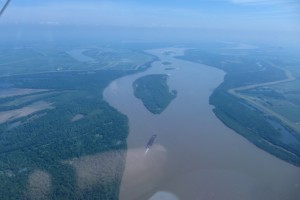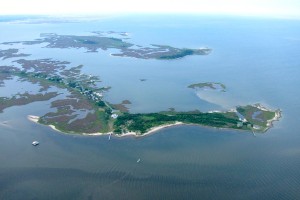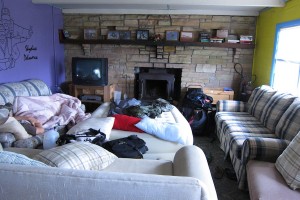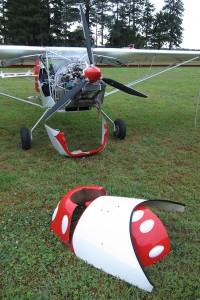 To be exact, I flew 1000.74 statute miles in three hops. I arrived at the airport at about 5:30 in the morning and opened the hangar doors for the last time. The airplane was fueled up and ready to go.
To be exact, I flew 1000.74 statute miles in three hops. I arrived at the airport at about 5:30 in the morning and opened the hangar doors for the last time. The airplane was fueled up and ready to go.
 I had to load up my backpack and strap it in the passenger seat. I also have a few other items tied in with it and my water bottle fits nicely between the two. I pulled her out and by the time I was done with the preflight the sky was just starting to lighten up in the east. I usually instruct in the early morning and I would often fly with students as the sun was just coming up and always wished that I was heading out on an adventure in my own airplane. Not that I don’t enjoy instructing but so much of my flying has been for purposes other than my own.
I had to load up my backpack and strap it in the passenger seat. I also have a few other items tied in with it and my water bottle fits nicely between the two. I pulled her out and by the time I was done with the preflight the sky was just starting to lighten up in the east. I usually instruct in the early morning and I would often fly with students as the sun was just coming up and always wished that I was heading out on an adventure in my own airplane. Not that I don’t enjoy instructing but so much of my flying has been for purposes other than my own.
 I took off a few minutes after 6:00 AM and realized my dream. The sun rising through distant clouds on a beautiful east Texas morning. A short time later I was flying into blinding sunlight but, if only for a few minutes, it was magical. The weather was forecast to be excellent along the entire route and I was cruising at about 120 MPH in smooth air. In about an hour N90HS was further from home than she had ever been before. Everything was functioning perfectly. That was not to be the case for the entire day but at least it was starting well.
I took off a few minutes after 6:00 AM and realized my dream. The sun rising through distant clouds on a beautiful east Texas morning. A short time later I was flying into blinding sunlight but, if only for a few minutes, it was magical. The weather was forecast to be excellent along the entire route and I was cruising at about 120 MPH in smooth air. In about an hour N90HS was further from home than she had ever been before. Everything was functioning perfectly. That was not to be the case for the entire day but at least it was starting well.
 As usual when flying, after reaching cruise altitude and everything has settled down it was time for the inflight meal. Todays selection was peanut butter on 12 grain bread and a granola bar. Washed down with water. I was glad the air was smooth so the inflight service was not canceled. There is really not a lot to do and I wanted to listen to music but I have misplaced my iPod and the cable to hook up my tablet was not easily reachable so the audio program was canceled for this leg of the journey. I promised myself that I would correct this situation at the next stop.
As usual when flying, after reaching cruise altitude and everything has settled down it was time for the inflight meal. Todays selection was peanut butter on 12 grain bread and a granola bar. Washed down with water. I was glad the air was smooth so the inflight service was not canceled. There is really not a lot to do and I wanted to listen to music but I have misplaced my iPod and the cable to hook up my tablet was not easily reachable so the audio program was canceled for this leg of the journey. I promised myself that I would correct this situation at the next stop.
After a three hour flight I landed at Kelly Airport in Oak Grove Louisiana for fuel and to stretch my legs. I was welcomed by Airport Commissioner Eddie Russell. I don’t think that would happen at O’hare or Hartsfield. If I stumbled into one of those airports unannounced I would most likely be met by some other sort of official, if you know what I mean. He was most hospitable and thanked me for stopping at their airport and gave me a rundown of the restaurants and services in Oak Grove. Eddie then helped me fuel up, I used the facilities and was back in the air in about 45 minutes.
 Not long after departing Oak Grove I crossed the Mississippi river. You can’t do that without taking a picture, so here it is. I was at about 3,500 feet and a short while later it was getting bumpy as the day grew warmer so I climbed up to 5,500 feet and stayed there for awhile until some clouds that were forming below me started to build up to my altitude and bring the bumps back with them. So, what to do? I climbed up to 7,500 feet which put me back in smooth air well above the cloud tops. The temperature was about 60 degrees and I was getting a little chilly so I turned on the heat and it was quite comfortable. I had solved the audio problem on the ground in Oak Grove so I was able to listen to some music as I cruised over Mississippi and Alabama.
Not long after departing Oak Grove I crossed the Mississippi river. You can’t do that without taking a picture, so here it is. I was at about 3,500 feet and a short while later it was getting bumpy as the day grew warmer so I climbed up to 5,500 feet and stayed there for awhile until some clouds that were forming below me started to build up to my altitude and bring the bumps back with them. So, what to do? I climbed up to 7,500 feet which put me back in smooth air well above the cloud tops. The temperature was about 60 degrees and I was getting a little chilly so I turned on the heat and it was quite comfortable. I had solved the audio problem on the ground in Oak Grove so I was able to listen to some music as I cruised over Mississippi and Alabama.
 When I was about 20 minutes from my destination I descended down between the clouds and back into the bumpy air. Although I liked the smooth air at 7,500 feet, the view of the ground from that height and through the clouds was not great. This was taken just as I was descending through the cloud layer somewhere over northern Alabama.
When I was about 20 minutes from my destination I descended down between the clouds and back into the bumpy air. Although I liked the smooth air at 7,500 feet, the view of the ground from that height and through the clouds was not great. This was taken just as I was descending through the cloud layer somewhere over northern Alabama.
 A short time later we were on the ground in Winchester Tennessee. Carolyn was on duty and she came out in her golf cart to help me refuel and tie Niner-Zero down. I went into their pilot’s lounge, poured some coffee and started planning my next leg. Carolyn got on her computer and made some suggestions and I decided that I could make it to Blacksburg Virginia and stop there for the evening. I took a loaner car into town to get some lunch and when I got back to the airport I napped in the pilot’s lounge for about an hour. I had plenty of time and the air would be smoother as the sun got lower.
A short time later we were on the ground in Winchester Tennessee. Carolyn was on duty and she came out in her golf cart to help me refuel and tie Niner-Zero down. I went into their pilot’s lounge, poured some coffee and started planning my next leg. Carolyn got on her computer and made some suggestions and I decided that I could make it to Blacksburg Virginia and stop there for the evening. I took a loaner car into town to get some lunch and when I got back to the airport I napped in the pilot’s lounge for about an hour. I had plenty of time and the air would be smoother as the sun got lower.
On the next leg all was going pretty well at first but after an hour I noticed that although the fuel level in the left wing tank was dropping the right tank was still full. There is a 13 gallon tank in each wing and a small “header” tank behind the seat that they both flow into. I have a fuel gauge for each wing tank. The header tank has a sensor at the top that lets me know if it is not full because if that happens I only have enough fuel for about 30 minutes at reduced power. When that happens a “low fuel” warning light illuminates on the panel. As I flew on, the left tank kept getting lower and lower and the right tank stayed full. I tried flying in a “slip” with the left wing low for several minutes to see if the fuel would flow from the right tank to the left tank. When I leveled off the left tank was still at about the same level and the right tank was still full.
About three hours into the flight the left tank was dry and I decided to land at New River Valley Airport in Dublin Virginia. Not quite as far as I had planned but I was confused as to what was going on. Then the low fuel warning light came on. THAT got my attention. I was at 7,500 feet and about 7 miles from the airport so I brought the power back to idle to conserve the fuel I had in the header tank. There was a Cessna 172 in the pattern and I was able to easily glide to the airport, enter the pattern and land uneventfully behind the Cessna without ever advancing the throttle above idle. After I landed the low fuel warning light went out and by the time I was tied down the left tank had some fuel and the fuel level in the right tank was decreasing. I got out and looked everything over and found a very large blue stain from the right fuel cap to the trailing edge of the wing. What was going on here?
I was not sure what had happened but my morning I had it figured out, or at least I had a theory. At Winchester I had fueled on a ramp that was not level and the right wing was lower than the left. I fueled the right tank, but not to the very top. The caps leak slightly so I do not fill all the way to the top. I then did the same with the left tank. I tied her down on the ramp, ate lunch and took a nap. When I did a preflight inspection I took a peak in each tank and the right tank was full to the top and a small amount of fuel had leaked out. It had flowed downhill through the header tank from the left tank. I did not think much of it and I took off for Blacksburg.
An airplane can fly because a low pressure area forms above the wing and a high pressure area forms below the wing. This is what creates “lift”. I think that this low pressure sucked fuel out of the right wing as there was no airspace and as a result is also pulled some fuel from the left tank along with the fuel that was going to the engine. The fuel that was sucked out of the tank stained the wing. 100 octane aviation fuel is blue and blue stains are often indicative of fuel leaks. After the left tank ran dry, some fuel was sucked out of the header tank and the low fuel warning light came on. Both tanks feed into the top of the header tank so only a small amount of fuel could be sucked out it but is was enough to activate the warning system. After I landed, the wing was no longer creating lift, the low pressure area was gone and fuel was able to flow back through the system to the header tank and then into the left tank. I think this is what happened but what does not make sense is that both fuel caps have steel tubes that exit the top of the caps and are bent into the airstream to alleviate just such a problem. The next morning I checked both of them and neither were clogged.
I researched the problem on the web and found that leaking caps are a common problem and that there is a cap seal gasket made by Mercedes that will cure the leaking cap problem. I ordered them and decided to make sure the tanks are not filled to the top for the next flight. Also, the next morning when I fueled, based on my expected fuel burn, it appeared that about 3 to 4 gallons of fuel had gone missing. Out over the wing perhaps?
I was safely on the ground in Dublin Virginia. I had flown over 1000 miles! I had flown into the Eastern Time Zone and had lost an hour and the airport office was closed. I started walking towards the Cessna 172 that had landed before me. It was getting dark and the pilot was gone but I saw some people and an open hangar a little further along. They were standing around messing with an old Cessna 150. I introduced myself and asked if there was anyway to get into the airport building after it closed or get someplace to eat. One of them, Rob, was the pilot of the Cessna. He runs the flight school and there was Scott, who runs the aircraft maintenance operation. Rob was flying the Cessna to warm up the oil so they could do a 100 hour inspection. I helped Rob push the Cessna back in the hangar and remove the cowlings. They had sent out for food and made a call to add a burger and salad for me. I gave what help I could and thoroughly enjoyed myself in the process.
 So, what to do for the night? I told them that I had a tent and would just set it up in the grass somewhere. They told me to just sleep in the hangar. They have a sofa, widescreen TV and a bathroom with a shower. Good deal. Here is a picture of the setup. I got my sleeping bag from the airplane and I was very comfortable. They also had some great entertainment on the widescreen, as you can see. It looks really cozy but . . .
So, what to do for the night? I told them that I had a tent and would just set it up in the grass somewhere. They told me to just sleep in the hangar. They have a sofa, widescreen TV and a bathroom with a shower. Good deal. Here is a picture of the setup. I got my sleeping bag from the airplane and I was very comfortable. They also had some great entertainment on the widescreen, as you can see. It looks really cozy but . . .
 To put it into context, it is really just the corner of a huge hangar. This was the end of my first day and I have already met some of the nicest people. Tomorrow I hope to make it to my hometown, Salisbury Maryland.
To put it into context, it is really just the corner of a huge hangar. This was the end of my first day and I have already met some of the nicest people. Tomorrow I hope to make it to my hometown, Salisbury Maryland.
 I finally got to give someone a ride Tuesday evening. My cousin Spencer had the honor. While we were taxiing out to the end of the runway I asked him how much he had flown and he told me that he had NEVER been in the air before. Although, he let me know he had spent a lot of time flying Microsoft Flight Simulator. I told him that did not count because his ass had never left the ground. Here he is with his hand on the controls while I try to take a picture of him He did a pretty good job once he got the hang of it.
I finally got to give someone a ride Tuesday evening. My cousin Spencer had the honor. While we were taxiing out to the end of the runway I asked him how much he had flown and he told me that he had NEVER been in the air before. Although, he let me know he had spent a lot of time flying Microsoft Flight Simulator. I told him that did not count because his ass had never left the ground. Here he is with his hand on the controls while I try to take a picture of him He did a pretty good job once he got the hang of it. Since I had a copilot I was able to open my door and take some pictures. The water in the background is the Chesapeake Bay. The island is all marsh with no dry land at all. A great place for fishing and crabbing I am sure. We were flying over the eastern side of the Nanticoke River when I took this picture of the sun setting in the west. Did not come out as nice as it looked when we were there. Was much more dramatic.
Since I had a copilot I was able to open my door and take some pictures. The water in the background is the Chesapeake Bay. The island is all marsh with no dry land at all. A great place for fishing and crabbing I am sure. We were flying over the eastern side of the Nanticoke River when I took this picture of the sun setting in the west. Did not come out as nice as it looked when we were there. Was much more dramatic. This was taken after we landed. We flew for just over an hour and Spencer seemed to enjoy the entire flight except perhaps for the steep turn demonstration. He became a little unsettled which is not unusual for his first experience with increased “g” forces. Two g’s in this case. This gives an idea of the view when the door is open. The black strap in the upper left is used to pull it closed. Sometimes I fly with my door open for the entire flight. The airplane handles the same but I keep the speeds down. Believe it or not, it is not that windy at all with the door open but it can get chilly.
This was taken after we landed. We flew for just over an hour and Spencer seemed to enjoy the entire flight except perhaps for the steep turn demonstration. He became a little unsettled which is not unusual for his first experience with increased “g” forces. Two g’s in this case. This gives an idea of the view when the door is open. The black strap in the upper left is used to pull it closed. Sometimes I fly with my door open for the entire flight. The airplane handles the same but I keep the speeds down. Believe it or not, it is not that windy at all with the door open but it can get chilly. I got back in the air yesterday morning for a couple of hours and spent much of the time with the door open. The Chesapeake Bay and its tributaries is home to dozens and dozens of small settlements clinging to small patches of dry land far out in the marsh but closer to the bay. Some are on islands and only accessible by boat. This one is connected to the mainland by a long narrow road over the marsh. Only a few feet above sea level, these roads flood often. Being out at here puts them closer to their livelihood, the Bay.
I got back in the air yesterday morning for a couple of hours and spent much of the time with the door open. The Chesapeake Bay and its tributaries is home to dozens and dozens of small settlements clinging to small patches of dry land far out in the marsh but closer to the bay. Some are on islands and only accessible by boat. This one is connected to the mainland by a long narrow road over the marsh. Only a few feet above sea level, these roads flood often. Being out at here puts them closer to their livelihood, the Bay. This is the same settlement and you can see the road stretching across the marsh. I think the structure that can be seen in the water just off shore is a “Shed House”. They enclose floating pens that contain hard shell blue crabs that are close to being ready to shed. This is how they grow and when they shed the new shell is soft for a few hours. They are collected at this point and become the “soft crabs” that are part of the local cuisine. We had smaller pens of this sort that we kept tied to our pier when I was growing up. A smaller version of the same operation seen here.
This is the same settlement and you can see the road stretching across the marsh. I think the structure that can be seen in the water just off shore is a “Shed House”. They enclose floating pens that contain hard shell blue crabs that are close to being ready to shed. This is how they grow and when they shed the new shell is soft for a few hours. They are collected at this point and become the “soft crabs” that are part of the local cuisine. We had smaller pens of this sort that we kept tied to our pier when I was growing up. A smaller version of the same operation seen here. I took this picture as I was heading back to Bennett Field. An old farmhouse by a creek that meanders towards a river and then the bay on the horizon. Driving up to a farm like this you might not even realize how close the water is. It never seems to be far away.
I took this picture as I was heading back to Bennett Field. An old farmhouse by a creek that meanders towards a river and then the bay on the horizon. Driving up to a farm like this you might not even realize how close the water is. It never seems to be far away.
















































